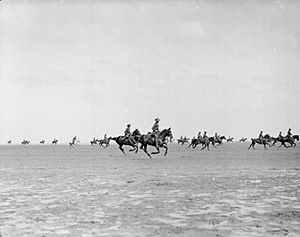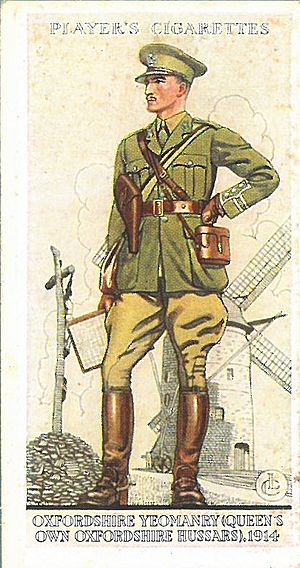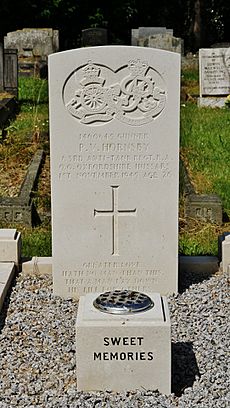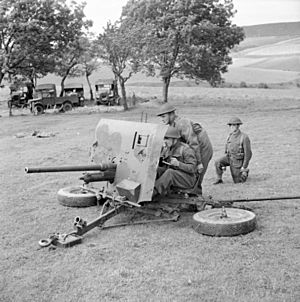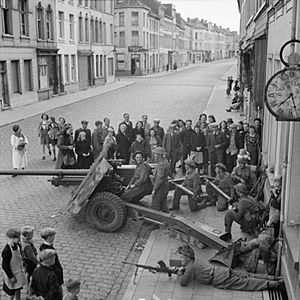Queen's Own Oxfordshire Hussars facts for kids
Quick facts for kids Queen's Own Oxfordshire Hussars |
|
|---|---|
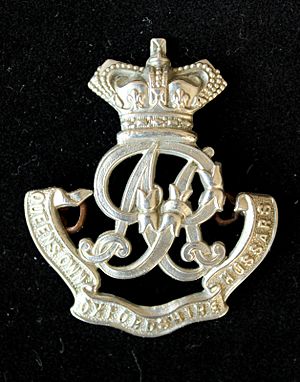
cap badge
|
|
| Active | May 1798–Present |
| Country | |
| Branch | |
| Type | Yeomanry |
| Role | Mounted infantry Second Boer War Cavalry World War I Artillery World War II Signals Port Maritime Present |
| Size | Squadron (current) |
| Part of | Royal Logistic Corps |
| Garrison/HQ | Banbury |
| Nickname(s) | Agricultural Cavalry |
| Colors | Mantua Purple |
| Engagements | |
| Battle honours | See Battle Honours below |
| Website | Queen's Own Oxfordshire Hussars |
| Commanders | |
| Colonel of the Regiment |
Winston Churchill |
The Queen's Own Oxfordshire Hussars (QOOH) was a special cavalry group in the British Army. It started in 1798. This group, called a Yeomanry Cavalry regiment, helped the regular army.
The QOOH fought in the Second Boer War in South Africa. They were also the first Yeomanry regiment to serve in Belgium and France during World War I. After fighting in Trench warfare for almost four years, the QOOH led the charge in the winning Hundred Days Offensive in 1918.
Later, in 1922, the QOOH became part of the Royal Artillery. During World War II, they were anti-tank gunners. They fought in Singapore and in North West Europe. Today, the group's history continues as 142 (Queen's Own Oxfordshire Hussars) Vehicle Squadron in the Royal Logistic Corps.
Contents
Early Days: French Wars
Britain got involved in the French Revolutionary Wars in the late 1700s. In 1794, the Prime Minister, William Pitt the Younger, suggested that counties form volunteer cavalry groups. These groups, called Yeomanry, would defend the country from invasion. They would also help keep order if there were problems.
In response, people in Oxford met and decided to form a troop. In May 1798, the County Fencible Cavalry was created in Watlington. Soon, three more troops were formed in the county:
When peace ended in 1803, the Bloxham & Banbury troop grew bigger. More troops were also created, like the Oxford Cavalry. One of these was led by Francis Spencer, 1st Baron Churchill, who was related to the Duke of Marlborough.
The 1800s: Changes and a Royal Name
After the French wars ended, the Yeomanry became less important. Some of the original groups joined together in 1818. They formed the North Western Oxfordshire Regiment of Yeomanry. This group was renamed the 1st Oxfordshire Yeomanry Cavalry in 1823.
However, the Yeomanry continued to shrink. The government even stopped paying them. In 1828, the regiment was officially closed down. But some troops kept serving without pay.
Then, in 1830, there were many protests across Britain. This led to the Yeomanry being brought back. The Oxfordshire regiment was restarted in December. They were called out several times to stop riots, like at Otmoor.
In 1835, Queen Adelaide visited. After her visit, the regiment was given a special name. On November 7, 1835, it became the 1st or Queen's Own Regiment of Oxfordshire Yeomanry Cavalry. It was also known as the Oxfordshire Yeomanry Cavalry (Queen's Own, Oxford).
Many members of the Spencer-Churchill family, including relatives of the Duke of Marlborough, served as officers. The regiment's main office was near Blenheim Palace. In 1888, the regiment officially became the Queen's Own Oxfordshire Hussars (QOOH).
Towards the end of the 1800s, Yeomanry units were grouped into brigades for training. The Oxfordshire Yeomanry joined with the Buckinghamshire Yeomanry. They formed the 2nd Yeomanry Brigade.
Fighting in the Boer War
In December 1899, Britain faced unexpected defeats in the Second Boer War in South Africa. The Boer farmers were skilled horsemen. The British government realized it needed more troops. On December 13, it was decided to let volunteer forces serve in South Africa.
A new force was created, called the Imperial Yeomanry (IY). This group was designed to be fast-moving, mounted infantry, like the Boers. Many volunteers joined quickly. About 240 men from Oxfordshire joined.
The Oxfordshire Yeomanry helped create two companies for the IY: the 40th and 59th (Oxfordshire) Companies. The 40th Company arrived in South Africa in February 1900. The 59th Company arrived in March.
The 10th Battalion IY, which included the 40th Company, fought in the Battle of Boshof. This was the first battle for the new Imperial Yeomanry. Even with little training, they fought bravely. Their commander, Lord Methuen, was very impressed.
The 15th Battalion, with the 59th Company, also joined Methuen's Column. This column became known as the 'Mobile Marvels'. They marched long distances quickly. They helped protect the main British army and relieve other trapped units.
The IY also took part in the "Great de Wet Hunt." This was a long chase to catch a Boer commander named Christiaan de Wet. The hunt lasted for months.
After a year of service, the Oxfordshire companies returned home in 1901. The QOOH earned its first special award, called a Battle honour: South Africa 1900–01.
The Imperial Yeomanry idea was a success. So, all Yeomanry regiments in Britain were changed to Imperial Yeomanry. The Oxfordshire unit became the Oxfordshire Imperial Yeomanry (Queen's Own Oxfordshire Hussars).
In 1902, Winston Churchill joined the QOOH as a captain. He remained a strong supporter of the regiment for his whole life. He even made sure they had a special place at his funeral.
World War I: The Great War
When World War I started in August 1914, the QOOH was called into action. Many soldiers volunteered to serve overseas. The regiment quickly prepared for war.
The QOOH was sent to France in September 1914. They were the first Yeomanry unit to go overseas. This was thanks to Winston Churchill, who was then in charge of the Navy. He wanted his own Yeomanry regiment to help.
First Battles in Ypres
The QOOH soon faced the German army near Ypres in Belgium. They were among the first volunteer units to fight. The fighting was very tough. The British army struggled to hold their ground.
The QOOH joined the 2nd Cavalry Brigade. They fought dismounted, meaning they fought on foot, like infantry. They helped fill gaps in the line and faced heavy attacks. The QOOH stayed with the 4th Cavalry Brigade for the rest of the war.
Life in the Trenches
The QOOH quickly learned about the harsh realities of war. Regular soldiers sometimes joked about them, calling them "Queer Objects On Horseback." But the QOOH fought bravely and earned respect.
As cavalry, they often waited for a chance to ride through enemy lines. But this rarely happened. Instead, they worked hard, bringing supplies and digging trenches. They often had to fight on foot in the trenches.
The QOOH was involved in major battles like the Second Battle of Ypres (1915) and the Battle of Cambrai (1917). They earned many Battle Honours.
The Final Push: 1918
In March 1918, the Germans launched a huge attack. The fighting became more open, which was better for cavalry. The QOOH helped hold the line and counter-attack. They fought fiercely, sometimes suffering many casualties.
The Allied forces then launched their own big attack, the Hundred Days Offensive, starting in August 1918. The QOOH played a key role. They advanced with tanks and infantry, pushing back the Germans. They covered many miles in a day.
The QOOH continued to lead the advance. They helped storm the Hindenburg Line, a strong German defense. They pushed across rivers and through towns. On November 11, 1918, the war ended. The QOOH was leading the charge when the Armistice with Germany came into effect.
After the war, the QOOH helped with the occupation of Germany. The regiment finally returned home in 1922.
Between the World Wars
After World War I, the QOOH reformed in Oxford. But the army decided it needed fewer mounted cavalry units. Many Yeomanry regiments, including the QOOH, were changed to artillery units.
In 1922, the QOOH became part of the Royal Field Artillery (RFA). They formed two batteries (groups of guns) within a larger artillery brigade. These batteries were based in Oxford and Banbury. In 1924, the RFA became the Royal Artillery (RA).
As World War II approached, the British Army prepared. In 1938, the artillery brigade was changed to an anti-tank regiment. The QOOH batteries became part of the new 63rd Anti-Tank Regiment. This regiment had its main office in Oxford.
World War II: Anti-Tank Gunners
When World War II began in September 1939, the 63rd Anti-Tank Regiment was called up. They were part of the 61st Division. They first trained in the UK and then moved to Northern Ireland.
One of the QOOH batteries, the 251st, was sent to form a new regiment. This new regiment, the 85th Anti-Tank Regiment, was sent to reinforce Singapore.
Fighting in Singapore
The 85th Anti-Tank Regiment arrived in Singapore in January 1942. They were quickly sent to defend the island. They fought bravely in rubber plantations and guarded air bases.
However, the Japanese forces were too strong. On February 15, 1942, the British forces in Singapore surrendered. The soldiers of the 85th Regiment, including the QOOH men, became Prisoners of War.
They were forced to march to Changi Prison. Later, many were forced to work on the terrible Death Railroad. This was a very harsh time, and many prisoners died from hard labor, hunger, and sickness.
Back to Europe
Meanwhile, the rest of the 63rd (Oxfordshire Yeomanry) Anti-Tank Regiment stayed in the UK. They were eager to join the fighting. Winston Churchill, who was still their Honorary Colonel, helped them. In 1944, he personally ordered them to France.
In France, the regiment joined VIII Corps. They were equipped with powerful 17-pounder anti-tank guns. Some of these guns were towed by special gun tractors (converted tanks), and some were mounted on self-propelled vehicles called 'Achilles'.
The QOOH fought in tough battles to clear German forces from areas in Belgium and the Netherlands. They helped in Operation Nutcracker, fighting in harsh winter conditions.
In December 1944, some QOOH soldiers joined other experienced anti-tank batteries. They continued to fight in the final push across Germany in 1945.
The 63rd Anti-Tank Regiment was one of the units that helped free the prisoners at the Belsen concentration camp in April 1945. They continued to advance across Germany. On May 5, 1945, the war in Europe ended.
The 63rd Anti-Tank Regiment stayed in Germany for occupation duties. It was officially closed down in May 1946.
After the Wars: New Roles
Royal Artillery Again
In 1947, the QOOH reformed in Oxford as an artillery regiment. It was named 387 (Queen's Own Oxfordshire Hussars) Field Regiment, RA.
Later, in 1950, it joined with another regiment, the Royal Bucks Yeomanry. It became 299 (Royal Bucks Yeomanry and Queen's Own Oxfordshire Hussars) Field Regiment, RA. The QOOH part formed Q Battery in Oxford and Banbury.
Royal Signals
In 1967, the army changed again. Some QOOH members joined the Royal Corps of Signals. In 1975, they became 5 (Queen's Own Oxfordshire Hussars) Signal Squadron. This helped keep the regiment's traditions alive.
Royal Logistic Corps Today
In 2014, the Queen's Own Oxfordshire Hussars became part of the Royal Logistic Corps (RLC). They now form 142 (QOOH) Vehicle Squadron based in Banbury. This squadron works within the 165 Port and Maritime Regiment RLC.
Special Traditions and Honours
Winston Churchill's Connection
Winston Churchill was the Honorary Colonel of the QOOH until he died in 1965. He had a very special connection with the regiment.
When he planned his own funeral, he gave the QOOH a special honour. He wanted them to be in a very important position right in front of his coffin. This was a huge honour, showing how much he valued them.
Uniforms and Symbols
Before World War I, the QOOH wore fancy uniforms. They had dark blue coats with white braiding and special purple parts. This unique "mantua purple" color was special to the regiment. They kept this color for parts of their uniforms even when they became artillery.
The QOOH also kept their own cap badge. When they wore their combat uniforms, they had "ROYAL ARTILLERY" on their shoulder. But they also wore a small metal "QOOH" on their shoulder strap.
Today, the squadron still uses the QOOH cap badge.
Battle Honours
The regiment earned many special awards called Battle honours for its bravery in battles. These honours are often shown on a special flag called a guidon.
- Second Boer War: South Africa 1900–1901
- World War I: Messines 1914, Armentières 1914, Ypres 1915, Arras 1917, Cambrai 1917 '18, Somme 1918, Lys, Amiens, Hindenburg Line, France and Flanders 1914–18
- World War II: The Royal Artillery usually doesn't get battle honours. Instead, their guns are seen as their colours, and they have the motto Ubique (meaning 'everywhere').
In 1998, the 5 (QOOH) Signal Squadron celebrated 200 years of the Oxfordshire Yeomanry. They were given the Freedom of Banbury, a special honour from the town.
Memorials and Museum
There are memorials to the QOOH from World War I. You can find them in Christ Church Cathedral, Oxford and at Oxford Town Hall.
The Soldiers of Oxfordshire Museum in Woodstock has items and information about the regiment's history.
|




